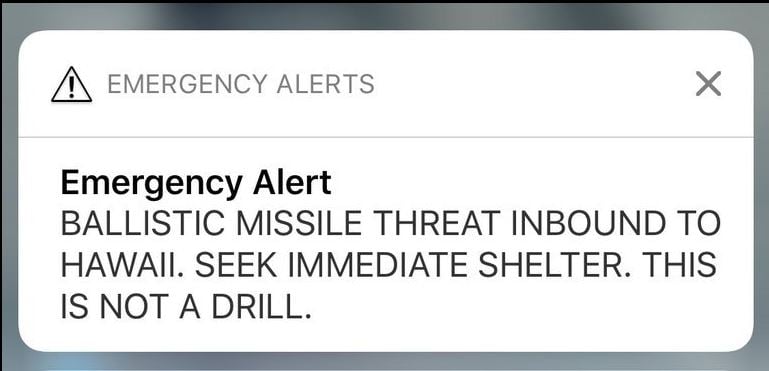I was using my home computer a few minutes after 8 AM on January 13 when the phone rang. My daughter called to tell me that she had received an alert message on her smart phone that a missile was headed toward Hawaii.

Screen capture of the text warning of the missile attack. (Source: Wikipedia)
I hadn’t heard any warning sirens so was inclined to think it was a hoax or a mistake. However, the alert had ended with an ominous “This is not a drill.” I tried to access the Hawaii Emergency Management Agency (HI-EMA) website but it was not responding. Shortly before 9 AM we learned that the alert had been a mistake.
After the false alert, a common question Hawaii residents asked each other is where they were and what they did. Some called friends and family. Some didn’t receive the alert and were blissfully unaware. That would have been me if not for my daughter’s call.
My reaction was stunned disbelief and frustration at the inability to access the HI-EMA website. My daughter has said that terrified seems like the best description of her reaction, except that she was so busy carrying food and water into a windowless bathroom of her Honolulu condominium that there wasn’t time to feel anything. Some University of Hawaii students tried to find fallout shelters on the Manoa campus but found buildings locked. (In his January 16 message, UH President David Lassner noted an effort to make improved plans to provide “crystal clear instructions in advance and during an event on where to shelter.”) In sum, it was a bad morning with lots of unpleasant lessons.
There has been a lot of media coverage of this event both locally and nationally. Initial reports claimed that an HI-EMA person clicked the wrong box on his computer as part of a ballistic missile alert drill during a shift change. However, this person subsequently stated that he thought the message he heard indicated a real attack and thus clicked the box to send the alert. This is still a point of contention.
A January 29 preliminary report on this incident and other information about the warning system is posted on the Hawaii Emergency Management Agency website. A press conference about the preliminary report, as well as a February 19 press conference on the release of a more detailed examination of HI-EMA and Hawaii’s preparedness for a broad range of hazards, is at the Defense Department’s website for Hawaii. The February 18 report is titled “All-Hazards Preparedness Improvement Action Plan and Report.”
Recommendations
The January 29 report focuses on the false alarm and how to prevent a similar problem in the future. The report found that it was too easy for one person to send such a message, and called for requiring a second person to confirm such a message. It also found that the system had not been designed to rapidly cancel alerts and send out an All Clear message to members of the public who had received the original alert, and that this capability should be added.
In addition, the report found serious problems with management and personnel that required changes. In particular, it said that the employee who broadcast the false alarm had been “a source of concern” for staff at the warning center “for over 10 years” and the report noted that this person had “confused real life events and drills on at least two separate occasions.” This issue was part of a larger problem that “Supervisors do not consistently ensure employee performance levels meet expectations” and that documented poor performance evaluations have “created morale and competency issues.”
The broader February 18 report gives 12 observations and 44 recommendations concerning four major areas: HI-EMA management review; technology improvements; enforcement of current statutes and executive orders; and training and education programs for the public, government leaders, and employees.
The report recommends that HI-EMA produce a Strategic Plan ($800,000 estimated cost) and an annex to the state’s plan to address chemical, biological, radiological, and nuclear (CBRN) threats. The Ballistic Missile Preparedness Campaign would be suspended except for monthly siren tests until this annex is complete. (The report notes that the public response to the January 13 alert showed that the public outreach campaign that started in March 2017 “was limited in its success.”)
The report also recommends training programs to improve performance of supervisors and employees.
Technology improvements would address why some cell phones and some areas did not receive the alert. Also, wireless networks were saturated on January 13 and service in Diamond Head Crater needs improvement. A static website is recommended because the HI-EMA servers crashed five minutes after they had received 40,000 hits within the first three minutes of the alert.
A public outreach campaign with missile threat-specific information is recommended after the CBRN annex to the state’s plan is completed. The outreach campaign has an estimated cost of $500,000 in addition to $875,000 to produce the CBRN annex.
The final recommendation deals with infrastructure improvements for multi-purpose shelters, harbors, airports, etc. with costs “to be determined.” The one item with an estimated cost of $135 million is for a Joint Emergency Management Center.
Coincidentally the false alert came while I was helping prepare an exhibit on the role of nuclear weapons since 1945 and connections to Hawaii. We hope that the exhibit will be a catalyst for informed dialogue about reducing the threat in the future.
Since January 13, Hawaii residents have personal reasons to take this seriously.

